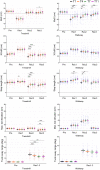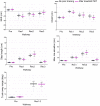Perturbation-Based Balance Training Using Repeated Trips on a Walkway vs. Belt Accelerations on a Treadmill: A Cross-Over Randomised Controlled Trial in Community-Dwelling Older Adults
- PMID: 34490425
- PMCID: PMC8417700
- DOI: 10.3389/fspor.2021.702320
Perturbation-Based Balance Training Using Repeated Trips on a Walkway vs. Belt Accelerations on a Treadmill: A Cross-Over Randomised Controlled Trial in Community-Dwelling Older Adults
Abstract
Background: Walkway and treadmill induced trips have contrasting advantages, for instance walkway trips have high-ecological validity whereas belt accelerations on a treadmill have high-clinical feasibility for perturbation-based balance training (PBT). This study aimed to (i) compare adaptations to repeated overground trips with repeated treadmill belt accelerations in older adults and (ii) determine if adaptations to repeated treadmill belt accelerations can transfer to an actual trip on the walkway. Method: Thirty-eight healthy community-dwelling older adults underwent one session each of walkway and treadmill PBT in a randomised crossover design on a single day. For both conditions, 11 trips were induced to either leg in pseudo-random locations interspersed with 20 normal walking trials. Dynamic balance (e.g., margin of stability) and gait (e.g., step length) parameters from 3D motion capture were used to examine adaptations in the walkway and treadmill PBT and transfer of adaptation from treadmill PBT to a walkway trip. Results: No changes were observed in normal (no-trip) gait parameters in both training conditions, except for a small (0.9 cm) increase in minimum toe elevation during walkway walks (P < 0.01). An increase in the margin of stability and recovery step length was observed during walkway PBT (P < 0.05). During treadmill PBT, an increased MoS, step length and decreased trunk sway range were observed (P < 0.05). These adaptations to treadmill PBT did not transfer to a walkway trip. Conclusions: This study demonstrated that older adults could learn to improve dynamic stability by repeated exposure to walkway trips as well as treadmill belt accelerations. However, the adaptations to treadmill belt accelerations did not transfer to an actual trip. To enhance the utility of treadmill PBT for overground trip recovery performance, further development of treadmill PBT protocols is recommended to improve ecological authenticity.
Keywords: accidental fall; balance training; exercise; gait; older adults; perturbation.
Copyright © 2021 Song, Sturnieks, Davis, Lord and Okubo.
Conflict of interest statement
The authors declare that the research was conducted in the absence of any commercial or financial relationships that could be construed as a potential conflict of interest.
Figures




References
LinkOut - more resources
Full Text Sources

